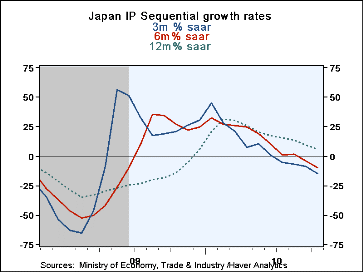 Global| Nov 30 2010
Global| Nov 30 2010All Growth Rates Agree – Can They All Be Wrong?
Summary
Japan’s industrial production index is slowing over three-months and over six months.It is also falling in each of the last five months and of course, over three months, and also over six months. Weakness in the output of consumer [...]
 Japan’s industrial production index is slowing over three-months and over six months.It is also falling in each of the last five months and of course, over three months, and also over six months.
Japan’s industrial production index is slowing over three-months and over six months.It is also falling in each of the last five months and of course, over three months, and also over six months.
Weakness in the output of consumer goods is pronounced with a decline of 22% at an annual rate over three-months. While less important overall, the decline in mining output even in the face of a global bubble in commodity prices is off at a nearly 40% annual rate over three-months, 30% over six months and is, along with consumer goods output, lower over 12 months as well.
Japan is hindered by a stalled domestic economy and weakness in its key export markets. The US consumer has been slow to revive in the expansion but there is some growth underway in the US. The strong yen makes it harder for Japanese firms to exploit that growth. China, Japan’s largest trading partner, having overheated, is now slowing down and that is weighing heavily on Japan.
Japan is beset with a shrinking population that stifles domestic demand and a heavy debt load that keeps the fiscal authorities reluctant to engage in too much fiscal spending. The Bank of Japan may be prepared to try more monetary stimulus, but Japan is truly caught under adverse circumstances having developed an export oriented model that links it to now weak economics, not having addressed its huge domestic debt bomb while times were good, and now being pulled back by the drag of demographics.
Japan faces a set of dangers that are related to but different from Europe’s. Japan runs huge current account surpluses but is still highly indebted, mostly to its own citizens, but that still counts as debt. It has tried to use monetary policy to escape its weakness and it has overused fiscal policy. Markets will not let it use foreign exchange rate policy. Like the Wizard of Oz Japan is running out of levers to pull.
| Japan Industrial Production Trends | |||||||||
|---|---|---|---|---|---|---|---|---|---|
| SA | M/M % | SAAR % | Yr/Yr | Q to Date | % of | ||||
| Oct10 | Sep10 | Aug10 | 3Mo | 6Mo | 12Mo | YrAgo | %AR | Cycle | |
| Mining&MFG | -1.8% | -1.6% | -0.5% | -14.7% | -9.9% | 6.1% | -14.2% | -17.0% | 82.7% |
| Industry | -2.0% | -1.7% | -0.3% | -15.0% | -9.7% | 5.8% | -13.9% | -18.0% | 83.1% |
| MFG | -1.9% | -1.5% | -0.6% | -15.1% | -9.9% | 6.1% | -14.2% | -17.3% | 82.7% |
| Textiles | -2.3% | -1.9% | 0.1% | -15.1% | -6.8% | 0.1% | -16.4% | -19.3% | 74.7% |
| Transp | -10.4% | -3.9% | -0.4% | -46.2% | -37.1% | -1.8% | -22.7% | -56.5% | 65.5% |
| Goods Product Group | |||||||||
| Consumer | -5.5% | -1.0% | 0.2% | -22.8% | -9.4% | -1.4% | -11.7% | -31.3% | 82.9% |
| Intermediate | -1.6% | -1.7% | -1.1% | -16.4% | -13.2% | 6.2% | -11.9% | -17.2% | 83.5% |
| Investment | 0.0% | -1.9% | 1.3% | -2.4% | -1.7% | 17.2% | -26.3% | -5.0% | 78.6% |
| Mining | -11.0% | 0.2% | -1.1% | -39.4% | -29.2% | -15.0% | -3.1% | -50.9% | 73.6% |
| Electric&Gas | -3.4% | -1.9% | 2.0% | -12.4% | -8.2% | 3.3% | -6.0% | -21.4% | 91.9% |
Robert Brusca
AuthorMore in Author Profile »Robert A. Brusca is Chief Economist of Fact and Opinion Economics, a consulting firm he founded in Manhattan. He has been an economist on Wall Street for over 25 years. He has visited central banking and large institutional clients in over 30 countries in his career as an economist. Mr. Brusca was a Divisional Research Chief at the Federal Reserve Bank of NY (Chief of the International Financial markets Division), a Fed Watcher at Irving Trust and Chief Economist at Nikko Securities International. He is widely quoted and appears in various media. Mr. Brusca holds an MA and Ph.D. in economics from Michigan State University and a BA in Economics from the University of Michigan. His research pursues his strong interests in non aligned policy economics as well as international economics. FAO Economics’ research targets investors to assist them in making better investment decisions in stocks, bonds and in a variety of international assets. The company does not manage money and has no conflicts in giving economic advice.






